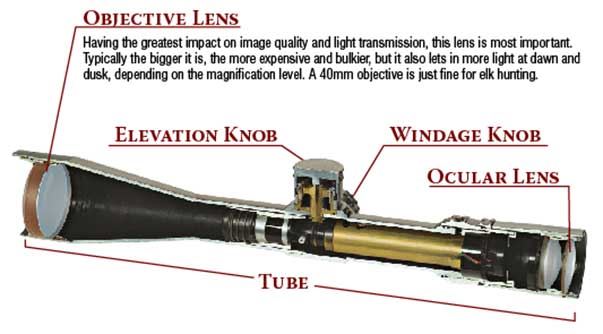For elk hunters, choosing a rifle is tough enough. Throw a scope in the mix, and it gets downright daunting. Plenty of elk died at the end of a set of old iron sights, but that’s not the case anymore. To help you navigate some of the ever-changing vernacular of “good glass,” we put together this scope tutorial. Hope it helps. 3-9×40
The first numbers (3-9) refer to the magnification power of the scope. In this case, the scope can adjust from three to nine times what we see with the naked eye. The last number (40) refers to the size in millimeters of the objective lens.Fixed vs. variable power scopes
A fixed-power scope means there is no zooming. What you see is what you get. It’s great for dense cover and hunters who like a steady reticle and a bright sight picture, with fewer moving parts to break down. Variable-power helps you zoom in closer for open-country shots and dial down for close quarters.Optical coatings
Multi-coated lenses work to optimize light transmission to your eye and reduce glare. Unless coated, lenses reflect 5 percent of that light away from your eye. Consider that scopes can have 10-16 lens elements, and you’re talking 50 percent loss of available light. MOA (minute of angle)
Relates to accuracy. It allows you to shift your crosshairs and line them up with your bullet’s path. If you shoot your rifle at 100 yards, and you are consistently off by 2 inches, you can use MOA to adjust to zero. MOA, roughly translated, means one inch at 100 yards. Most scopes adjust in ¼-inch MOA increments. If your off by 2 inches, you need to click the scope’s knob eight times to bring it to zero.Eye Relief
Simply put, this is the distance from your shooting eye to the eyepiece. Most hunters allow 3-4 inches of relief, and for bigger, magnum rifles with more punch, allow as much as you can.Got gas?
During production, manufacturers will typically fill the space between a scope’s lenses with nitrogen, argon or krypton gas. The gas prevents moisture build-up, decreasing the likelihood of a fog-up of the worst kind—inside the scope.
Reticles
Scope manufacturers are hard-pressed to make their product stand out from the competition, which is why they make an array of options available to consumers. Reticle styles are no exception.Standard Crosshair
For those hunters who know their gun and its bullets, keeping it simple with this reticle is the way to go. It’s by far the most popular reticle because it’s simple, fast and effective in a wide-range of situations. Mil Dot
Long story short, Mil means milradian, not military. Like MOA, mil dots are relative to distance. A mil in a reticle subtends 3.6 inches at 100 yards. Double that number for 200 yards, triple for 300 yards and so on. A mil is 36 inches at 1,000 yards. Snipers and varmint hunters like it. BDC (Bullet Drop Compensating)
An amalgam of many reticles, this design takes a lot of the guesswork out of holdover. It doesn’t compensate for wind, elevation or user error. Though with time, companies will likely eliminate those variables, too.German #4
A variation on the original crosshair, this reticle is best for you rhino hunters out there. It centers your eye quickly on fast-approaching targets in brushy conditions.
